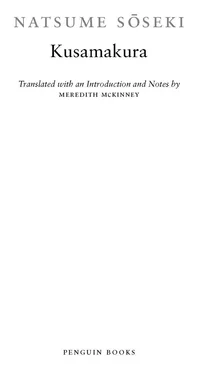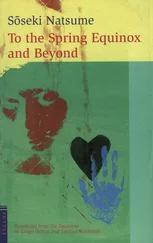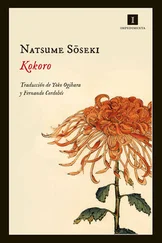Natsume Soseki - Kusamakura
Здесь есть возможность читать онлайн «Natsume Soseki - Kusamakura» весь текст электронной книги совершенно бесплатно (целиком полную версию без сокращений). В некоторых случаях можно слушать аудио, скачать через торрент в формате fb2 и присутствует краткое содержание. Жанр: Старинная литература, на английском языке. Описание произведения, (предисловие) а так же отзывы посетителей доступны на портале библиотеки ЛибКат.
- Название:Kusamakura
- Автор:
- Жанр:
- Год:неизвестен
- ISBN:нет данных
- Рейтинг книги:4 / 5. Голосов: 1
-
Избранное:Добавить в избранное
- Отзывы:
-
Ваша оценка:
- 80
- 1
- 2
- 3
- 4
- 5
Kusamakura: краткое содержание, описание и аннотация
Предлагаем к чтению аннотацию, описание, краткое содержание или предисловие (зависит от того, что написал сам автор книги «Kusamakura»). Если вы не нашли необходимую информацию о книге — напишите в комментариях, мы постараемся отыскать её.
Kusamakura — читать онлайн бесплатно полную книгу (весь текст) целиком
Ниже представлен текст книги, разбитый по страницам. Система сохранения места последней прочитанной страницы, позволяет с удобством читать онлайн бесплатно книгу «Kusamakura», без необходимости каждый раз заново искать на чём Вы остановились. Поставьте закладку, и сможете в любой момент перейти на страницу, на которой закончили чтение.
Интервал:
Закладка:
Stil suspended in the water, I next try my hand at composing a eulogy to the drowned figure.
Rain dampens
And the frost chil s.
Al is dark within the earth.
But in spring waters there’s no pain
Afloat on waves . . .
Sunk beneath waves . . .
I am floating there aimlessly, intoning these lines softly to myself, when from somewhere I hear the plucked notes of a shamisen . Now, for a man who cal s himself an artist, it’s embarrassing to confess that I have almost no notion of matters to do with the shamisen; my ears have scarcely ever registered the difference between one modal tuning and another. But listening idly to the sound of those distant strings makes me wonderful y happy, lying here in a hot bath in a remote mountain vil age, my very soul adrift in the spring water on a quiet vernal evening, with the rain adding to the delight of the occasion. From this distance I have no idea what piece is being sung or played, which too holds a certain charm. But judging from the relaxed timbre of the notes, it might be something from the repertoire of the great blind Kamigata performers, played on a thick-necked shamisen.
When I was a child, a sake shop by the name of Yorozuya stood outside our front gate. On quiet spring afternoons the daughter of the establishment, a girl cal ed Okura, would always take up her shamisen and practice the old nagauta songs she was studying. Whenever Okura began to play, I would slip out into the garden to hear her. We owned a plot for growing tea, around forty square yards, in front of which, to the east of the guest room, stood a row of three pine trees. They were tal trees, about a foot in girth, and the interesting thing was that they were visual y pleasing only as a group, not individual y. The sight of them always made me happy as a child. Beneath the pines crouched a garden lantern of rusted black iron on a slab of some kind of red rock, grim and immovable, like an obstinate little old man. I used to love to gaze at it. Around this lantern the nameless grasses that had pushed up through the mossy earth tossed fancy-free in the world’s fickle winds, casting their scent and taking their pleasure in their own sweet way. I discovered a place to squat among these grasses, a space just big enough for my knees to fit, and my habit at this time of year was to go and sit there, absolutely stil . Each day I settled down beneath those pines, glaring back at the grim little lantern and sniffing the scent of the grasses, as I listened to Okura’s distant shamisen.
Okura must by now be wel into marriage, and her face across the sake shop counter would be that of a solid householder. Do she and her husband get along wel ? Do the swal ows stil come back each year to those eaves, their busy little beaks laden with mud? Since that time I have never been able to separate in my imagination the sight of swal ows and the smel of sake. Are those three pines stil there, forming their elegant configuration? The iron lantern has certainly disintegrated by now. Do the spring grasses remember the boy who used to squat among them? No, how would they now recognize someone who even then passed only mutely through their lives? Nor, surely, do they retain any memory of the daily echo of Okura’s voice as she sang “The Hemp Robe of the Mountain Monk,†accompanying herself on the shamisen.
Those plucked notes have spontaneously recal ed for me a vision of the nostalgic past, and I am transfixed, once again the artless boy who inhabited that world of twenty years ago—when suddenly the bathhouse door slides smoothly open.
Someone’s come in, I think, turning my eyes to the doorway as I float. My head is resting on the rim farthest from the door, and the steps leading down to the bathtub are diagonal y visible to me about twenty feet away. But my searching eyes stil cannot discern any figure there. I wait alertly, hearing only the sound of the raindrops along the eaves. The notes of the shamisen have ceased without my noticing.
A long moment later a form appears at the top of the steps. The large bathhouse is lit by a single smal lamp hung from the ceiling, so even if the air were free of steam, it would be hard to make out anything clearly at this distance; now, with the thick steam held down by the evening’s fine rain and prevented from escaping, I cannot discern the identity of the standing figure. Unless it descends one step and its foot goes to the second, and the ful light of the lamp bathes it, addressing this figure as either man or woman is impossible.
The dark shape takes a step down. The stone seems velvet soft; indeed, to judge by the sound alone, one could easily believe the shape hasn’t moved at al . But now the outline swims hazily into view. Being an artist, my senses are unusual y acute when it comes to the human frame. The moment the ambiguous figure moves, I understand that the person in the bathroom with me is a woman.
Before I can decide, as I float there, whether to warn her of my presence, the woman has appeared in her ful ness before me. As I see her there, deep within the warm brimming steam that the mil ion soft particles of light have tinged a hazy pink, her black hair drifting about her like a cloud, and her body held poised and erect, al thoughts of politeness, decorum, and moral conduct flee my mind; I am gripped by the single fervent conviction that I have discovered the subject for a splendid painting.
I cannot speak for classical Greek sculpture, but certainly those nudes that contemporary French artists are so committed to painting give me clear evidence of a striving to depict the blatant splendor of the human flesh, as wel as keen disappointment at the lack of any real grace and refinement in the depiction. At the time I merely registered the fact that these works are somehow vulgar, but I realize now that I have al this time been troubled by my failure to understand the reason for their lack of taste. If the flesh is clothed, the beauty of it is hidden; but unless it is hidden, it becomes vulgar. Today’s artists of the nude do not limit their skil s to depicting the vulgarity of the unhidden; they are not content simply to present the human form denuded of its clothes. They do their best to thrust the naked figure out into the world of the ful y dressed. They forget that being dressed is the normal state of man, and they attempt to bestow complete authority on the naked form. In their eagerness to cry out to the viewer, “Look, here is a nude!†they push beyond al natural bounds. When technique reaches such extremes, people are likely to judge it as a vulgar coercion of the viewer. The attempt to make a beautiful thing appear yet more beautiful only detracts from its intrinsic beauty. “Riches breed loss,†as the old saying about worldly affairs goes.
Reverie and innocence signify composure of mind, which is a necessary condition for painting, poetry, and indeed literature in general. The greatest evil in our present age of art is that the tide of civilization has swept artists along on its crest, goading them to an incessant state of pettiness and fussiness. The nude in art is a good example. The city has what are known as geisha, who trade in the art of flirtation and the erotic. In their dealings with the client, their only expressions are those calculated to make themselves appear as attractive as possible to him. Year after year the catalogs of our gal eries are fil ed with nude beauties who resemble these geisha. Never for an instant do they forget their nakedness; indeed, their flesh squirms with the effort to display it to the viewer.
The graceful beauty before my eyes at this moment has about her not one jot of this crude worldliness. Normal people who divest themselves of their clothes thereby lower themselves to the baser realm of human existence, but she is as natural as a figure conjured from the cloudy realms of the age of the gods, innocent of any necessity for clothes and draperies.
Читать дальшеИнтервал:
Закладка:
Похожие книги на «Kusamakura»
Представляем Вашему вниманию похожие книги на «Kusamakura» списком для выбора. Мы отобрали схожую по названию и смыслу литературу в надежде предоставить читателям больше вариантов отыскать новые, интересные, ещё непрочитанные произведения.
Обсуждение, отзывы о книге «Kusamakura» и просто собственные мнения читателей. Оставьте ваши комментарии, напишите, что Вы думаете о произведении, его смысле или главных героях. Укажите что конкретно понравилось, а что нет, и почему Вы так считаете.












